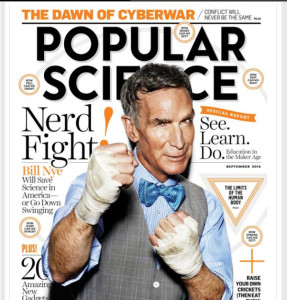 Well known science educator and celebrity, Bill Nye, a.k.a. Bill Nye the Science Guy, is fighting to save science in America according to the September issue of Popular Science magazine.
Well known science educator and celebrity, Bill Nye, a.k.a. Bill Nye the Science Guy, is fighting to save science in America according to the September issue of Popular Science magazine.
The article is titled, “Bill Nye Fights Back – How a mild-mannered children’s celebrity plans to save science in America—or go down swinging.” In the 1990s Nye filmed 100 episodes of Bill Nye the Science Guy, where Nye earned his status as a “friendly explainer of all things scientific.”
Now, Nye is going toe-to-toe in debates and other public speaking events to try and prevent what the article cites as “ill-informed parents undoing his life’s work.” This from the opening of the article which covers an interview with Nye as he prepare to debate Ken Ham, the founder and leader of the Answers in Genesis ministry and the Creation Museum.
Through his ministry and museum, Ham preaches, among other things, that the Earth is only roughly 6000 years old and that dinosaurs walked the Earth at the same time as Adam and Eve.
This belief is in total opposition to all of the scientific data which puts the age of the Earth at 4.5 billion years. Hundreds of millions of years separate the dawn on mankind from the age of the dinosaurs.
Nye points out that the U.S. appears to be moving toward scientific illiteracy. The concern is illustrated in the article by some research polls. One found that nearly 45 percent of Americans believed humans came to be by a process other than evolution, while another found that one in two Americans don’t believe that humans are causing climate change, despite the fact that about 98 percent of all scientists do (a greater consensus than supports the link between cigarette smoking and lung cancer).
“To Nye, science is under siege, and he is not about to sit back and watch the thing he loves and staked his career on suffer.”
The complete article can be found in the September 2014 issue of Popular Science, and can also be read online at: http://www.popsci.com/node/135793/?cmpid=enews082114&spPodID=020&spMailingID=6956059&spJobID=502234685&spReportId=NTAyMjM0Njg1S0.
![Herbal Reference Substances are Key to Everyday Products <!-- AddThis Sharing Buttons above -->
<div class="addthis_toolbox addthis_default_style " addthis:url='http://newstaar.com/herbal-reference-substances-are-key-to-everyday-products/3512112/' >
<a class="addthis_button_facebook_like" fb:like:layout="button_count"></a>
<a class="addthis_button_tweet"></a>
<a class="addthis_button_pinterest_pinit"></a>
<a class="addthis_counter addthis_pill_style"></a>
</div>When it comes to quality control testing and the development of new products, Botanical Reference Materials (BRMs), also known as Herbal References are critically important. To help companies ultimately obtain all-important FDA approval, the Food and Drug Administration provides in its guidance a recommendation that […]<!-- AddThis Sharing Buttons below -->
<div class="addthis_toolbox addthis_default_style addthis_32x32_style" addthis:url='http://newstaar.com/herbal-reference-substances-are-key-to-everyday-products/3512112/' >
<a class="addthis_button_preferred_1"></a>
<a class="addthis_button_preferred_2"></a>
<a class="addthis_button_preferred_3"></a>
<a class="addthis_button_preferred_4"></a>
<a class="addthis_button_compact"></a>
<a class="addthis_counter addthis_bubble_style"></a>
</div>](http://newstaar.com/wp-content/uploads/2021/02/Achillea_millefolium_flowers-100x100.jpg)
![Quality Electrochemical Biosensors are Critical for Medical, Food and Chemical Industry <!-- AddThis Sharing Buttons above -->
<div class="addthis_toolbox addthis_default_style " addthis:url='http://newstaar.com/quality-electrochemical-biosensors-are-critical-for-medical-food-and-chemical-industry/3512086/' >
<a class="addthis_button_facebook_like" fb:like:layout="button_count"></a>
<a class="addthis_button_tweet"></a>
<a class="addthis_button_pinterest_pinit"></a>
<a class="addthis_counter addthis_pill_style"></a>
</div>A number of industries have, at their core, a need to frequent or even continuous analysis of biological media. These include the medical and pharmaceutical fields, biotech firms, and food and chemical companies. To maintain quality standards and develop new products, these industries rely heavily […]<!-- AddThis Sharing Buttons below -->
<div class="addthis_toolbox addthis_default_style addthis_32x32_style" addthis:url='http://newstaar.com/quality-electrochemical-biosensors-are-critical-for-medical-food-and-chemical-industry/3512086/' >
<a class="addthis_button_preferred_1"></a>
<a class="addthis_button_preferred_2"></a>
<a class="addthis_button_preferred_3"></a>
<a class="addthis_button_preferred_4"></a>
<a class="addthis_button_compact"></a>
<a class="addthis_counter addthis_bubble_style"></a>
</div>](http://newstaar.com/wp-content/uploads/2020/10/Electrochemical-Biosensor-100x100.jpg)
![Company Develops Industrial Mixers Well-Suited for both Fragile and Explosive Products <!-- AddThis Sharing Buttons above -->
<div class="addthis_toolbox addthis_default_style " addthis:url='http://newstaar.com/company-develops-industrial-mixers-well-suited-for-both-fragile-and-explosive-products/3512071/' >
<a class="addthis_button_facebook_like" fb:like:layout="button_count"></a>
<a class="addthis_button_tweet"></a>
<a class="addthis_button_pinterest_pinit"></a>
<a class="addthis_counter addthis_pill_style"></a>
</div>Industrial drum mixers are normally applied to blend mixes of varying viscosities such as adhesive slurries or cement. Some of these mixers have the capability of blending mixes of very different particle sizes such as fruit and ice cream, and gravel and cement slurry. The […]<!-- AddThis Sharing Buttons below -->
<div class="addthis_toolbox addthis_default_style addthis_32x32_style" addthis:url='http://newstaar.com/company-develops-industrial-mixers-well-suited-for-both-fragile-and-explosive-products/3512071/' >
<a class="addthis_button_preferred_1"></a>
<a class="addthis_button_preferred_2"></a>
<a class="addthis_button_preferred_3"></a>
<a class="addthis_button_preferred_4"></a>
<a class="addthis_button_compact"></a>
<a class="addthis_counter addthis_bubble_style"></a>
</div>](http://newstaar.com/wp-content/uploads/2020/06/bandeau-sofragir2-100x100.jpg)